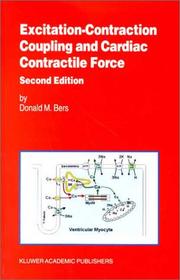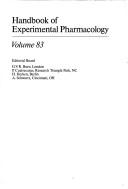| Listing 1 - 3 of 3 |
Sort by
|

ISBN: 0792371577 0792371585 940100658X Year: 2001 Publisher: Dordrecht Boston : Kluwer Academic Publishers,
Abstract | Keywords | Export | Availability | Bookmark
 Loading...
Loading...Choose an application
- Reference Manager
- EndNote
- RefWorks (Direct export to RefWorks)
How is the heartbeat generated? What controls the strength of contraction of heart muscle? What are the links between cardiac structure and function? How does our understanding of skeletal and smooth muscle and non-muscle cells influence our thinking about force development in the heart? Are there important species differences in how contraction is regulated in the heart? How do the new molecular data fit together in understanding the heart beat? What goes wrong in ischemia, hypertrophy, and heart failure? This book paints a modern `portrait' of how the heart works and in this picture the author shows a close-up of the structural, biochemical, and physiological links between excitation and contraction. The author takes the reader through a series of important, interrelated topics with great clarity and continuity and also includes many useful illustrations and tables. The book starts by considering the cellular structures involved in excitation-contraction coupling and then described the characteristics of the myofilaments as the end effector of excitation-contraction coupling. A general scheme of calcium regulation is described and the possible sources and sinks of calcium are discussed in simple, but quantitative terms. The cardiac action potential and its many underlying currents are reviewed. Then the characteristics of some key calcium transport systems (calcium channels, sodium/calcium exchange and SR calcium uptake and release) are discussed in detail. This is then built into a more integrated picture of calcium regulation in succeeding chapters by detailed discussions of excitation-calcium coupling mechanisms (in skeletal, cardiac, and smooth muscle), the interplay between calcium regulatory processes, and finally mechanisms of cardiac inotropy, calcium overload, and dysfunction (e.g., ischemia, hypertrophy, and heart failure). Excitation-Contraction Coupling and Cardiac Contractile Force &endash; Second Edition is an invaluable source of information for anyone who is interested in how the heart beat is controlled and especially suited for students of the cardiovascular system at all levels from medical/graduate students through senior investigators in related fields.
Blood physiology. Circulatory physiology --- Heart --- Calcium --- Calcium channels. --- Excitation (Physiology) --- Myocardial Contraction --- Myocardium --- Contraction. --- Physiological effect. --- physiology. --- metabolism. --- Medicine --- Health & Biological Sciences --- Cardiovascular Diseases --- Cardiology. --- Internal medicine --- Diseases

ISBN: 3540174117 0387174117 3642718086 364271806X Year: 1988 Volume: vol 83 Publisher: Berlin Heidelberg New York Springer
Abstract | Keywords | Export | Availability | Bookmark
 Loading...
Loading...Choose an application
- Reference Manager
- EndNote
- RefWorks (Direct export to RefWorks)
Geneesmiddelen. Fysiologisch effect. (Versch. onderwerpen) --- Calcium. Receptoren / in de farmacologie. (Versch. onderwerpen) --- Calcium / en thérapeutique. (Mélanges) --- Médicaments. Effets physiologiques. (Mélanges) --- Calcium. Récepteurs / en pharmacologie. (Mélanges) --- Calcium / in de therapie. (Versch. onderwerpen) --- Calcium --- Calcium channels --- Drugs --- Therapeutic use --- Testing. --- Effect of drugs on. --- Receptors --- Physiological effect. --- physiology.
Book
ISBN: 9782889192991 Year: 2014 Publisher: Frontiers Media SA
Abstract | Keywords | Export | Availability | Bookmark
 Loading...
Loading...Choose an application
- Reference Manager
- EndNote
- RefWorks (Direct export to RefWorks)
The calcium-calmodulin dependent protein kinases (CaMKs) are a broadly expressed family of calcium-sensitive intracellular kinases, which are responsible for transducing cytosolic calcium signals into phosphorylation-based regulation of proteins and physiological functions. As the multifunctional member of the family, CaMKII has become the most prominent for its roles in the central nervous system and heart, where it controls a diverse range of calcium-dependent processes; from learning and memory at the neuronal synapse, to cellular growth and death in the myocardium. In the heart, CaMKII directly regulates many of the most important ion channels and calcium handling proteins, and controls the expression of an ever-increasing number of transcripts and their downstream products. Functionally, these actions are thought to orchestrate many of the electrophysiologic and contractile adaptations to common cardiac stressors, such as rapid pacing, chronic adrenergic stimulation, and oxidative challenge. In the context of disease, CaMKII has been shown to contribute to a remarkably wide variety of cardiac pathologies, of which Heart failure (HF) is the most conspicuous. Hyperactivity of CaMKII is an established contributor to pathological cardiac remodelling, and is widely thought to directly promote arrhythmia and contractile dysfunction during HF. CaMKII is also ubiquitous in non-failing arrhythmia-susceptible phenotypes, several of which result from specific channelopathies that mimic constitutive channel phosphorylation. Because CaMKII contributes to both the acute and chronic manifestations of major cardiac diseases, but may be only minimally required for homeostasis in the absence of chronic stress, it has come to be one of the most promising therapeutic drug targets in cardiac biology. Thus, development of more specific and deliverable small molecule antagonists remains a key priority for the field. Here we provide a selection of articles to summarize the state of our knowledge regarding CaMKII in cardiac health and disease, with a particular view to highlighting recent developments in CaMKII activation, and new targets in CaMKII-mediated control of myocyte physiology.
Cardiovascular Diseases --- Medicine --- Health & Biological Sciences --- Phosphorylation --- Ion Channels --- Calcium --- arrhythmia --- Heart Failure --- Hypertrophy
| Listing 1 - 3 of 3 |
Sort by
|

 Search
Search Feedback
Feedback About UniCat
About UniCat  Help
Help News
News